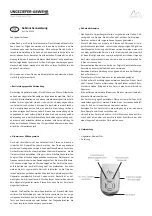
LISA-U series - System Integration Manual
UBX-13001118 - R17
Advance information
Features description
Page 164 of 190
3.17
Network Friendly Mode
Not supported by “x0”, “x1”and “x2” product versions
The Network Friendly Mode (NFM) feature provides a more efficient access to the network since it regulates the
number of network accesses per service type over a configurable amount of time, avoiding scenarios in which
the cellular module continuously retries a registration or a PDP context activation procedure until it is successful.
In case of appropriate network rejection errors, a back-off timer can be started: when the timer is running or the
number of allowed accesses is reached, further attempts are denied and an URC may be enabled to indicate the
time remaining before a further attempt can be served. The back-off timer controls the temporal spread of
successive attempts to register to CS or PS services, to activate a PDP context and to send SMS messages.
For more details, see the
u-blox AT Commands Manual
3.18
Power saving
The power saving configuration is by default disabled, but it can be enabled using the AT+UPSV command.
When power saving is enabled, the module automatically enters the low power idle-mode whenever possible,
reducing current consumption.
During the low power idle-mode, the module is not ready to communicate with an external device by means of
the application interfaces, since it is configured to reduce power consumption. The module wakes up from the
low power idle-mode to the active-mode in these events:
Automatic periodic monitoring of the paging channel for the paging block reception according to network
conditions (see sections 1.5.3.3, 1.9.2.3)
Automatic periodic enable of the UART interface to receive and send data, if AT+UPSV=1 has been set (see
section 1.9.2.3)
Data received on UART interface, if HW flow control has been disabled by AT&K0 and AT+UPSV=1 has been
set (see section 1.9.2.3)
RTS
input set ON by the DTE if HW flow control has been disabled by AT&K0 and AT+UPSV=2 has been set
(see section 1.9.2.3)
DTR
input set ON by DTE if AT+UPSV=3 has been set (supported only by all LISA-U2 series modules except
for ”x0” and “x1” product versions, see section 1.9.2.3)
USB detection, applying 5 V (typ.) to
VUSB_DET
input (see section 1.9.3)
The connected USB host forces a remote wakeup of the module as USB device (see section 1.9.3)
The connected SPI master indicates by means of the
SPI_MRDY
input signal of the module that it is ready
for transmission or reception over the SPI interface (see section 1.9.4)
The connected u-blox GNSS receiver indicates by means of the
GPIO3
pin previously configured for the
“GNSS data ready” function that it is ready to send data over the I
2
C / DDC interface (see sections 1.10,
RTC alarm previously configured by AT command (see
u-blox AT Commands Manual
[3], AT+CALA)
For the complete description of the AT+UPSV command, see the
u-blox AT Commands Manual
For the definition and the description of LISA-U series modules operating modes, including the events forcing
transitions between the different operating modes, see section 1.4.
For the description of current consumption in idle and active operating modes, see sections 1.5.3.3, 1.5.3.4.
For the description of the UART behavior related to module power saving configuration, see section 1.9.2.3.
For the description of the USB behavior related to module power saving configuration, see section 1.9.3.2.
For the description of the SPI behavior related to module power saving configuration, see section 1.9.4.2.
















































